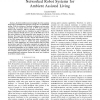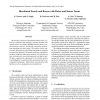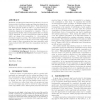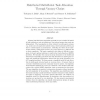47 search results - page 9 / 10 » Cooperative self-organization in a heterogeneous swarm robot... |
SUTC
2010
IEEE
13 years 9 months ago
2010
IEEE
—Robotic middlewares increasingly allow the seamless integration of multiple heterogeneous robots into one distributed system. With the inclusion of ambient intelligence and perv...
FSR
2003
Springer
13 years 10 months ago
2003
Springer
We develop a network of distributed mobile sensor systems as a solution to the emergency response problem. The mobile sensors are inside a building and they form a connected ad-ho...
GECCO
2009
Springer
13 years 11 months ago
2009
Springer
Evolution of multi-agent teams has been shown to be an effective method of solving complex problems involving the exploration of an unknown problem space. These autonomous and het...
GECCO
2009
Springer
13 years 11 months ago
2009
Springer
Evolution has proven to be an effective method of training heterogeneous multi-agent teams of autonomous agents to explore unknown environments. Autonomous, heterogeneous agents ...
ICRA
2003
IEEE
13 years 10 months ago
2003
IEEE
Existing task allocation algorithms generally do not consider the effects of task interaction, such as interference, but instead assume that tasks are independent. That assumptio...




